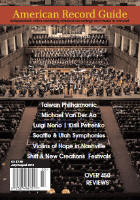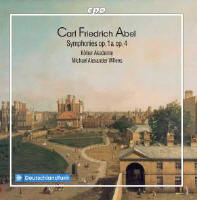Texte paru dans: / Appeared in: |
|
|
Outil de traduction ~ (Très approximatif) |
|
|
Reviewer: Paul
L. Althouse
The father of Carl Friedrich
Abel (1723-87) was a close friend of JS Bach, and Bach was godfather to Carl
Friedrich’s older sister, born 1720. Abel studied with his father, who died
in 1737, after which he went to Leipzig and (according to Burney, who knew
Abel) worked with Bach. Following Leipzig Abel lived in Dresden, spending
his early career working under Hasse. Around 1759 he settled in London,
where, along with Johann Christian Bach (born 1735), he became a dominant
musical force in the world’s most prosperous city. He left a substantial
body of instrumental work, but no opera. These symphonies, six in each opus,
are scored for strings, horns, and oboes, though the winds seldom supply
anything more than chordal support; all include harpsichord continuo as
well. The works were published from about 1760 to 1762, shortly before the
business association with JC Bach, which began late in 1763, resulting in
the Bach-Abel concerts (1765 to 1781.) Abel’s symphonies are laid out like Italian overtures: three movements (fast, slow, fast) with opening movements showing the clear key distinction of sonata form. The symphonies average about seven minutes in length, none going more than nine minutes. The music is cheerful and lively, with charming slow movements (usually marked Andantino), An occasional rocket theme reminiscent of the Mannheim school will show up, but there is no real suggestion of sturm und drang or counterpoint to challenge the listener. This is interesting if you want to hear the style that was to become Mozart’s, but actually the works of JC Bach are closer to Mozart, particularly the lyrical second themes. Nonetheless, we should remember that Abel had a good relationship with the young Mozart, who spent about a year in London in 1765. Furthermore, one of Abel’s symphonies (Op. 6: 6) was copied by Mozart and for a time was regarded as Mozart’s (K 18).
The performances by the Cologne Academy capture the lightness and energy of the music to fine effect. They play without vibrato at baroque pitch, so these CDs will appeal more to collectors who prefer period instruments. The music is pleasant and charming, but nothing is distinctive enough to hang in the memory, and after a while it all sounds too much alike. They are best appreciated in small doses. | |
|
|
|
|
Cliquez l'un ou l'autre
bouton pour découvrir bien d'autres critiques de CD |
|




